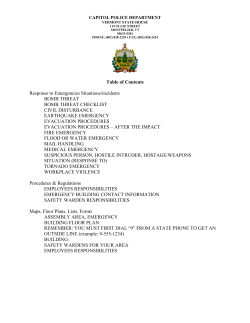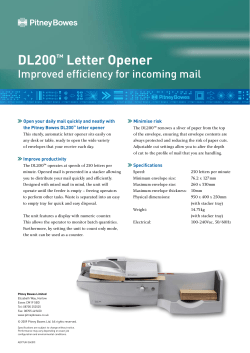
Loss Control TIPS Preparing for and Responding to
Loss Control TIPS Technical Information Paper Series Innovative Safety and Health Solutions SM Preparing for and Responding to Bomb Threats and Letter Bombs Introduction While bombings instigated by terrorists, vandals, or disgruntled employees are not a new phenomenon, an increased number of bombing incidents in recent years has heightened awareness of this threat to individuals, businesses, and the public well-being. Since it is impossible to predict if, when, where, or how a bomb or bomb threat might affect your facility, you must be prepared at all times to respond to a real bomb or a bomb threat. About 5-10 percent of bomb threats involve real bombs. Targets include individuals, businesses, schools, and public or government facilities. Perpetrators may be motivated by revenge, vandalism, political or religious convictions, or mental illness. The information presented here is intended to be used as a guide. For maximum protection, develop detailed emergency preparedness policies and procedures tailored to your facility. Work with police and other local officials to make best use of the resources in your community. About Different Kinds of Bombs A bomb is an explosive device capable of injuring and killing people and of damaging or destroying property and buildings when it is detonated or ignited. Most bombs are homemade and will likely be one of three types: explosive, letter, or incendiary. Explosive Bombs Explosive bombs cause damage through fragmentation (like shrapnel), heat, and blast waves. Shrapnel may cause injuries or death to people nearby. Heat may also cause secondary fires. Blast waves can damage or destroy buildings or vehicles and kill or injure people. Explosive bombs may be planted in buildings or in vehicles. Preparing for and Responding to Bomb Threats and Letter Bombs © 2002 The Hartford Loss Control Department TIPS S 570.050 Page 1 Letter Bombs Letter bombs (also called mail bombs or package bombs) are explosive devices in containers designed to look like letters or packages. The U.S. Postal Inspection Service reports that of 170 billion pieces of mail processed in a typical year, only a very few letter bombs—an average of 16—are reported or investigated. However, this number is on the increase. Because it is impossible for the Postal Inspection Service to inspect each piece of mail, mail recipients must assume a large share of the responsibility for protecting themselves against letter bombs. Letter bombs can often be identified by their odd shape or packaging, by the way in which the package is addressed, or by odd characteristics such as protruding wires or a strange smell (see letter bomb checklist in the appendix). Incendiary Bombs Incendiary bombs (also called fire bombs or “molotov cocktails”) cause fire without substantial explosion or blast. They generally consist of a fragile container (such as a glass bottle) filled with a flammable liquid (such as gasoline) with a source of ignition (such as a rag stuffed in the bottle to serve as a wick). They are easily and cheaply made, difficult to trace, and a favorite weapon of rioters and vandals. Straight vs. Concealed Bombs A bomb may be a straight bomb, in which no attempt has been made to make the bomb look anything different than what it is; or it may be a concealed bomb, one that has been disguised to resemble some other object (such as a briefcase or package). Time Delays and Remote Controls Bombs may be triggered by time delay mechanisms (can delay detonation from a few seconds to several months), remote controls (radio transmitter and receiving device), or target (victim)activated devices, which rely on some action by the intended victim (e.g., opening a letter bomb). Be Prepared for Bomb Threats at Your Facility Take a proactive approach: be prepared. Do all you can to protect your employees, facilities, and other assets from damage caused by a bomb and from the loss of productivity caused by panic, evacuations, and media attention. Develop an Emergency Preparedness Plan Develop an Emergency Preparedness Plan (EPP), which includes policies, procedures, and resources for preparation, response, and recovery from real and threatened emergencies. Include provisions for bombs and bomb threats. Appoint an Emergency Coordinator and an Emergency Response Team. Train security personnel to respond to bomb threats and situations. Keep employees, emergency responders, and community officials informed of your emergency preparedness plans so that affected individuals and organizations can act effectively should the need arise. Preparing for and Responding to Bomb Threats and Letter Bombs © 2002 The Hartford Loss Control Department TIPS S 570.050 Page 2 Develop a Procedural Flow Chart Develop a flow chart or procedure for how to deal with a bomb threat (see sample flow chart). For example, suppose that a bomb threat call is made to your facility’s switchboard operator. Following the predetermined plan, the operator gathers appropriate information (e.g., time of call, exact words of caller) and asks appropriate questions (e.g., “Where is the bomb? What does it look like?”). (See sample checklist.) The switchboard operator immediately notifies the Emergency Coordinator and the police department; the Emergency Coordinator activates the Emergency Preparedness Plan. Develop Evacuation Procedures Establish procedures to authorize, initiate, and accomplish evacuation, sheltering, and personnel accountability. Hold evacuation drills regularly so that all occupants will be familiar with evacuation routes and routines. Review Security Policies and Procedures Review security policies and procedures to ensure that bomb situations are taken into consideration. Establish effective security against bombs and bomb situations. Review Building Security Review security against building and car bombs. Follow standard recommendations for physical and access security. Do not allow parking within 300 feet of the building. If this is not possible, allow only properly identified company or employee vehicles to park closest to your facility. Control traffic access to loading docks, etc. Screen all individuals entering the facility. Keep doors, windows, and other entrances shut and locked when not in use. Screen all packages and bags brought in by visitors and employees. Instruct all employees to report any suspicious individuals, behavior, vehicles, or packages. Review security against letter bombs. Centralize mail facilities, and locate them away from other work areas. Train mailroom personnel to recognize and respond to suspicious packages. Provide training to non-mailroom staff in other departments who screen, sort, or distribute mail. Get a portable x-ray machine to screen suspicious packages. Instruct all employees to report any suspicious mail or packages, including special deliveries. Review Fire Prevention and Protection Plans Ensure that your facility has an effective fire prevention and protection program. Practice good housekeeping to reduce fire risk; keep the facility clean and free from flammable and combustible materials. Preparing for and Responding to Bomb Threats and Letter Bombs © 2002 The Hartford Loss Control Department TIPS S 570.050 Page 3 What to Do When A Bomb Threat is Received Assume that every threat is a real one, but don’t overreact. Terrorists want to disrupt operations and cause panic. Telephoned Threats Telephoned Threats. The person who takes the call and speaks to the caller should record as much information as possible. Use a bomb threat call checklist (see sample). Make every effort to keep the caller talking and on the line (so that the call might be traced). Notify a supervisor or coworker that a bomb threat is in progress. Keep calm, listen to the caller, do not interrupt, and remain courteous. Ask the caller to repeat information, as a means of prolonging the conversation. Record all information gathered during the call, as well as any impressions of a qualitative nature. Written Threats Written Threats. Notify appropriate officials immediately. Save all materials from written bomb threats (envelopes, containers, phone notes, etc.). Do not handle these materials more than necessary, to preserve fingerprints or other evidence. Responding to a Real Threat If a Threat Appears to Be Genuine. Engage the Emergency Preparedness Plan. Deploy the facility’s Emergency Coordinator and the Response Team to their appropriate roles and responsibilities. Notify security, supervisors, and building management personnel, but no one else. Let the appropriate people contact the police, bomb squad, media, etc. The Emergency Coordinator will make decisions about what actions to take immediately (ignore the threat, evacuate immediately, search the facility, delay evacuation, etc.). What to Do When a Suspicious Package is Received Notify supervisor and internal security. Call the Postal Inspection Service, who will send technicians to examine and possibly dispose of the item. Call the police. Photograph or videotape the item, or make a written description. Handle it as little as possible, both to prevent detonation and to preserve evidence. Store it in a remote but open place until officials arrive. Do not put it into an enclosed space (such as a drawer or cabinet) or under water. Bomb Searches Let the local bomb squad supervise and conduct any bomb search, accompanied by someone who is familiar with the building. Do not use radio communications during the search, as the radio signal might set off a bomb. Preparing for and Responding to Bomb Threats and Letter Bombs © 2002 The Hartford Loss Control Department TIPS S 570.050 Page 4 If a Bomb is Found Do not touch, move, tamper with, or attempt to detonate any bomb or suspicious object or package. Identify its exact location, and report this information to the appropriate personnel. Run a string or piece of tape from the bomb to the nearest building entrance so that bomb technicians can get to the bomb quickly and unaided. If necessary, place sandbags or mattresses around, never on, the suspicious object. Do not cover the object. Block off the danger zone, with a clearance of at least 300 feet around the suspicious object (this includes floors above and below). Open all doors and windows to minimize blast damage. Evacuate the building. Do not permit re-entry until the object has been disarmed or removed and until the building has been declared safe. If a Bomb Explodes Activate the Emergency Response Plan. Evacuate survivors and injured people. Search for injured and dead. Account for everyone. Get medical attention for injured people. Initiate other emergency services (fire suppression, security cordon, etc.). Be alert for gas and water leaks, electrical hazards, falling materials, etc. Be extremely cautious entering a damaged building; collapse could occur. Notify proper authorities. Remember that there could be a second bomb in the area, set to go off where evacuees or emergency personnel may be congregating. Conduct a careful and thorough search for more bombs. Be alert for additional threats or other communication from the perpetrator(s). Preserve evidence. Take pictures, use a video camera, and make notes. Make sure that evacuees and survivors are kept available for interviews by appropriate authorities. Maintain security at the site to prevent looting and vandalism. Evacuation Planning Evacuation of employees and visitors from the facility is the first priority during an emergency. A bomb or bomb threat situation may require the evacuation of all or part of the facility. Decisions about evacuation must be made only by a person who is authorized to do so, according to the facility’s Emergency Preparedness Plan. This will probably be the Emergency Coordinator or his or her designate. To control panic, an evacuation must be carried out in a controlled manner under the direction of authorized personnel. Evacuation and sheltering procedures should include information about conditions under which an evacuation is ordered, individuals responsible for ordering the evacuation, evacuation routes and maps, etc. Be sure to consider needs for transportation, shelter, water, and food. Preparing for and Responding to Bomb Threats and Letter Bombs © 2002 The Hartford Loss Control Department TIPS S 570.050 Page 5 Personnel accountability procedures should designate an assembly area (and alternate area) where personnel should gather after an emergency; include a head-count system; and establish procedures for accounting for visitors, customers and vendors. Do not use elevators during a bomb threat evacuation, as elevators are likely places for bombs. What NOT to Do in a Bomb Situation Do not panic. Do not touch, move, tamper with, or attempt to open or detonate any suspicious package. Do not discuss what is going on; leave this to the person designated to communicate with the public and the media. Do not contact the media. Communicating with Employees, the Public, and the Media Your facility’s Emergency Preparedness Plan should include procedures to alert and warn employees of emergencies. Employees should understand the types of communication methods that are in place within their organization (e.g., public address system). Each employee should know how to operate the equipment (e.g., how to activate alarms and fire extinguishers). Your EPP should also include a notification flow chart for the Emergency Response Team and other EPP members. The notification chart can include: 1. 2. 3. 4. 5. 6. 7. 8. Emergency Coordinator Response Team Senior management Outside response organizations Neighboring businesses Employees’ families Customers Media Appoint a single person (with backup) to serve as your organization’s spokesperson for dealing with the media and the public. No one else should discuss the situation with outsiders or the media. This policy ensures that only accurate, consistent information will be issued to the media and to the public. Conclusion Every individual, business, school, and public or government facility is vulnerable to bombs and bomb threats. Because bomb incidents are rare and unpredictable, it’s tempting to regard the threat as one unlikely to affect your facility. However, effective planning and preparation could make all the difference in preventing or mitigating a disaster for your employees, your business, your property, and your community. Preparing for and Responding to Bomb Threats and Letter Bombs © 2002 The Hartford Loss Control Department TIPS S 570.050 Page 6 References Bintliff, Russell L. The Complete Manual of Corporate and Industrial Security. Englewood Cliffs, NJ: Prentice-Hall, c1992. Handbook of Loss Prevention and Crime Prevention, 3rd ed., ed. by Lawrence J. Fenelly. Boston: Butterworth-Heinemann, c1996. Hofmann, Mark A. “Expert Tips to Defuse Mail Bomb Risks.” Business Insurance, January 13, 1997, pp. 1, 44 Office and Office Building Security, 2nd ed., by Ed San Luis et al. Boston: ButterworthHeinemann, c1994. Pouzar, Ed. “Defusing Threats.” Public Risk, October 1996, pp. 16-17. Preparing for Emergencies: A Program for Business Survival. New York: American Insurance Services Group, Engineering and Safety Service, c1991. Ryan, James H. “Before the Bomb Drops.” Management Review, August 1995, pp. 39-42. Security Manager’s Handbook, 2nd ed. Waterford, CT: Bureau of Business Practice, c1989; revised c1992. Siljander, Raymond P. Introduction to Business and Industrial Security and Loss Control: A Primer for Public Law Enforcement and Private Security Personnel. Springfield, IL: Charles C. Thomas, c1991. Stringfield, William H. Emergency Planning and Management: Ensuring Your Company’s Survival in the Event of a Disaster. Rockville, MD: Government Institutes, c1996. Other information, especially about letter and mail bombs, was provided by the United States Postal Service and the Department of the Treasury (Bureau of Alcohol, Tobacco, and Firearms). Detailed information is available at the ATF’s home page on the World Wide Web (http://www.atf.treas.gov) For more information, contact your local Hartford agent or your Hartford Loss Control Consultant. Visit The Hartford’s Loss Control web site at http://www.thehartford.com/corporate/losscontrol/ This document is provided for information purposes only. It is not intended to be a substitute for individual legal counsel or advice on issues discussed within. Readers seeking resolution of specific legal issues or business concerns related to the captioned topic should consult their attorneys and/or insurance representatives. Preparing for and Responding to Bomb Threats and Letter Bombs © 2002 The Hartford Loss Control Department TIPS S 570.050 Page 7 Flow Chart for Response to a Bomb Threat Bomb Threat Call Bomb Threat Checklist Information Gathering Notification Call Police or FBI Emergency Coordinator Assessment Yes No Maybe Search Procedures Yes Discover No Bomb? Call Bomb Disposal Unit Alert Medical Shut Down Procedures Activate Emergency Response Team Hoax; No Response Needed Alert Fire Access Control Evacuation Procedure Source: Planning for Emergencies, American Insurance Services Group Preparing for and Responding to Bomb Threats and Letter Bombs © 2002 The Hartford Loss Control Department TIPS S 570.050 Page 8 Bomb Threat Checklist Keep calm. Listen. Do not interrupt. Be courteous. Keep the caller talking. Ask the caller to repeat information. Record information. Notify a supervisor or co-worker that a bomb threat is in progress. Exact time of call: PM AM Exact words of caller: Date: Day of Week: Mon Tue Wed Thur Fri Sat Sun QUESTIONS TO ASK: 1. 2. 3. 4. 5. 6. 7. 8. 9. 10. When is the bomb going to explode?___________________________________________________________ Where is the bomb? ________________________________________________________________________ What does it look like? _____________________________________________________________________ What kind of bomb is it? ____________________________________________________________________ What will cause it to explode? ________________________________________________________________ Did you place the bomb? ____________________________________________________________________ Why? ___________________________________________________________________________________ Where are you calling from? _________________________________________________________________ What is your address? ______________________________________________________________________ What is your name? ________________________________________________________________________ CALLER’S VOICE SOUNDED LIKE: (check all that apply) Voice Qualities Normal Soft/Quiet Loud Slow Rapid Squeaky/High Deep Whispering Shouting Broken Calm Excited Demeanor Nasal Ragged Raspy Breathy Cracking Caller is: Male Female Adult Child Sincere Disguised Angry Stressed Sincere Crying Giggling Laughing Intoxicated Righteous Clears throat Irrational Accent Accented Local Accent No Accent Foreign: Describe accent? Distorted Familiar? Sounds like who? Language Uneducated Educated Distinct Slurred Stuttering Lisp Foreign Lang? Foul Message Spoken Taped Read BACKGROUND NOISE SOUNDED LIKE: (check all that apply) Surroundings Office Construction Traffic Party Household Kitchen Noises Factory Street PA System Music Machines Bells Static Siren Preparing for and Responding to Bomb Threats and Letter Bombs © 2002 The Hartford Loss Control Department TIPS S 570.050 Telephone Call Quiet Voices Laughter Animals TV Page 9 Internal call External call Phone booth Local Long distance Bomb Threat Checklist, continued Name and position of the person who received and/or handled the call: ___________________________ ____________________________________________________________________________________ ____________________________________________________________________________________ Call received at (location): ______________________________________________________________ Call received at phone number:___________________________________________________________ Caller ID or similar ability? _____________________________________________________________ Call reported to:_______________________________________________________________________ Call reported at (date and time): __________________________________________________________ Additional remarks ____________________________________________________________________ ____________________________________________________________________________________ IMPORTANT PHONE NUMBERS: POSITION OR AGENCY PERSON TO CONTACT Emergency Coordinator Emergency Coordinator Backup Security Local FBI Office Local US Postal Inspection Service Local Bureau of Alcohol, Tobacco, and Firearms Police Local Bomb Squad Fire Department Ambulance Mayor or other local official Hospital Preparing for and Responding to Bomb Threats and Letter Bombs © 2002 The Hartford Loss Control Department TIPS S 570.050 Page 10 PHONE NUMBER Responding to Letter and Mail Bombs How to Recognize a Letter or Mail Bomb Letter bombs, also called mail bombs or package bombs, might display one or more of these elements, although not all may apply to every suspicious package: mailed from a foreign country excessive postage; stamps versus metered mail no return address, or false return address postmark differs from return address restrictive or special handling instructions (“special delivery,” “air mail,” or “foreign mail”) misspelled words; poorly written or typed; poor handwriting; labels of cut-and-paste letters addressed to a specific individual wrong title with name of addressee, or addressed to a title but without a specific name restrictive instructions (“to be opened by addressee only,” “personal,” “confidential,” or “private”) addressee is not familiar with name and address of sender visual distractions (drawings, unusual statements, hand-drawn postage) letter-sized or larger package rigid, lumpy, or bulky envelope; stiffer or heavier than normal irregularly shaped or unevenly weighted package lopsided weight; soft spots or bulges messily wrapped package; different types of tape; excessive wrapping or taping; string marked “fragile,” “rush,” “handle with care,” or “do not delay” protruding wires, aluminum foil odd smells oily stains or discolorations What to Do When a Suspect Package or Letter is Received Do not open any suspect letter or package. Letter bombs may be triggered by a pressure release activated when the package is opened or when a string is cut. Isolate the suspect package, but do not put it into an enclosed space (such as a drawer or cabinet) or under water. Open windows in the immediate area. Contact police and other security officials immediately (bomb disposal unit, fire department, hospital, municipal officials, etc.). Activate the response team of the Emergency Preparedness Plan Make decisions about evacuation. Security Against Letter Bombs Centralize mail facilities, and locate them away from other work areas. Train mailroom personnel to recognize and respond to suspicious packages Provide training to non-mailroom staff in other departments who screen, sort, or distribute mail. Get a portable x-ray machine to screen suspicious packages. Instruct all employees to report any suspicious mail or packages, including special deliveries. Preparing for and Responding to Bomb Threats and Letter Bombs © 2002 The Hartford Loss Control Department TIPS S 570.050 Page 11
© Copyright 2025















